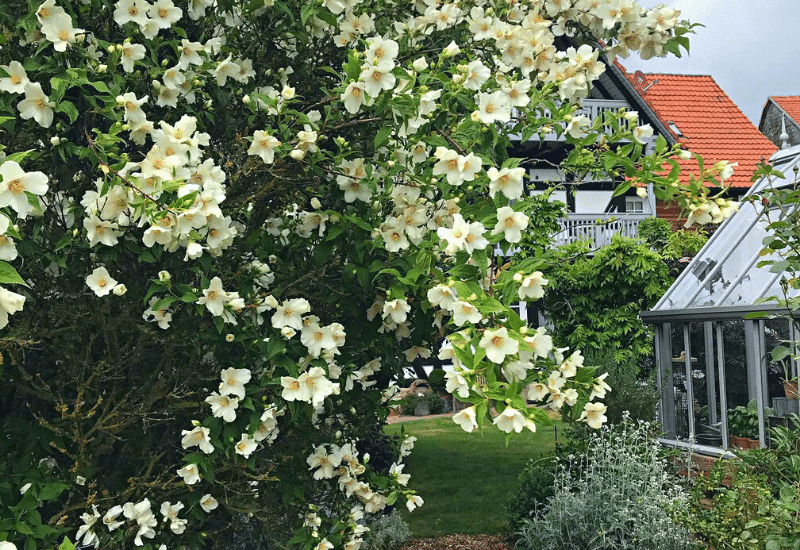
Spring flowering shrubs mark the arrival of warm weather by bringing light, colors, and vitality to your garden after all winter’s dreary browns and grays.
Early spring blooming bushes like forsythia, and flowering quince wake up as soon as winter is over, around March and April, when the temperatures rise and the days slowly begin to lengthen.
On the other hand, gorgeous late spring bloomers such as mock orange and California lilac are waiting for life to have fully resumed once the weather has warmed enough to flourish.
Year after year, they will welcome the new season with blooms, butterflies, and bees, but they won’t leave you alone after that… They will freshen up your outdoor spaces with beautiful foliage till fall and beyond.
Evergreen or Deciduous, white or colorful bloom, fragrant or not, for Sun or shade, the varieties of shrubs that bloom in spring (sometimes from early spring through early summer) is endless.
So get ready to welcome it, light up your garden or spring container, and help your imagination… Just look at these spring-flowering shrubs and give your green space a splash of life early in the season!
Ready? Let’s meet our protagonists.
16 Shrubs With Stunning Spring Blooms
Magnificent from the end of the winter, here are the 16 most beautiful spring flowering shrubs, which are among the first to adorn your gardens, balconies, and terraces with their magnificent blooms.
1: Forsythia (Forsythia spp.)
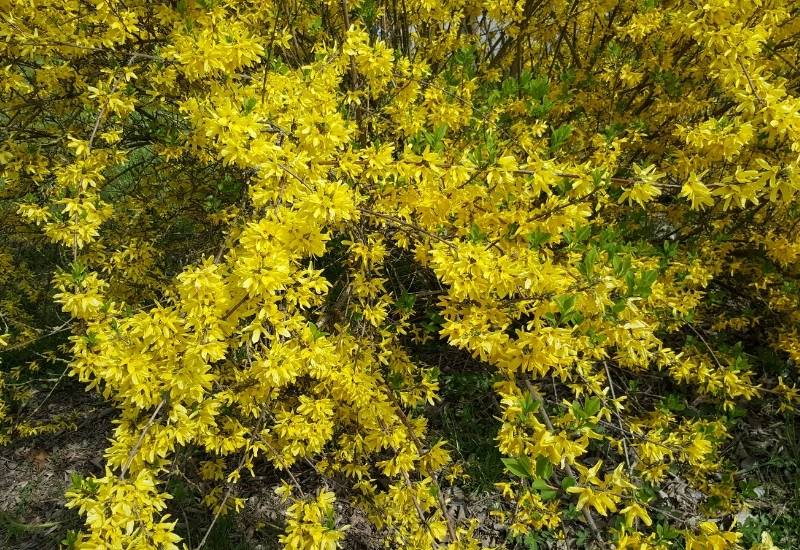
Spring and forsythia are almost synonymous. The massive yellow blooms of this shrub can be seen from a distance, and they totally cover and light up the whole bush from the end of winter.
There is real strength in numbers with this energetic plant! Green foliage will follow and stay on till frost, and there are varieties with arching branches (Korean forsythia, or Forsythia ovata), weeping bushes (weeping forsythia, or Forsythia suspensa), and those with upright branches too (Forsythia x intermedia ‘Lynwood Valley’).
Fast-growing and very vigorous, forsythia is a great early spring flowering shrub, ideal for natural-looking borders and hedges, even in naturalized areas. It is ideal to obtain a large effect in a short time.
2: Weigela (Weigela florida)
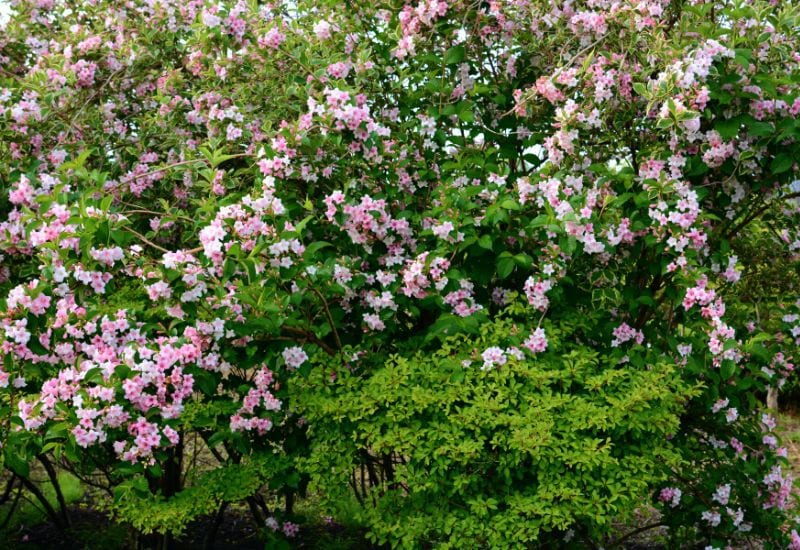
Weigelia is an ideal spring-flowering shrub for landscaping, thanks to its dense foliage and generous blooms. At the end of spring, the many bell-shaped flowers appear in abundant numbers on the arching branches in May or even earlier in warmer countries, and they continue into the beginning of summer.
They can be white, pink, or magenta, according to the variety, and they look up into the sky. The foliage is elliptical, small but dense, and it can be green, variegated, and even copper, like in the cultivar ‘My Monet Sunset.’
Weigela is ideal for herbaceous borders and hedges; it suits traditional and informal green spaces, especially cottage and English country gardens.
3: Lilac (Syringa vulgaris)
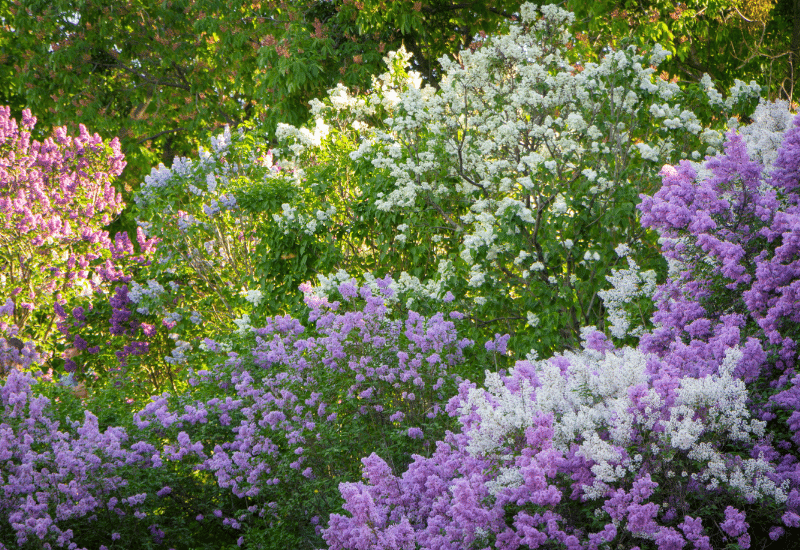
Lilac offers your spring garden the white to violet purple range with all the shades and hues in between. The thick panicles of fragrant flowers that arch from the branches are generous and jaw dropping, making this shrub one of the world’s favorites.
The heart shaped leaves of lilac plants will keep a fresh look till the end of summer, adding a soothing effect to your garden.
Cold hardy and low maintenance, it is an ideal fast growing shrub for an explosion of color in the early season. The blooms are short, but they are worth it!
Lilac varieties give you a good range of choice for natural looking settings, like traditional gardens and even wild areas, at the back of borders or in hedges and wind screens.
4: Flowering Quince (Chaenomeles spp.)
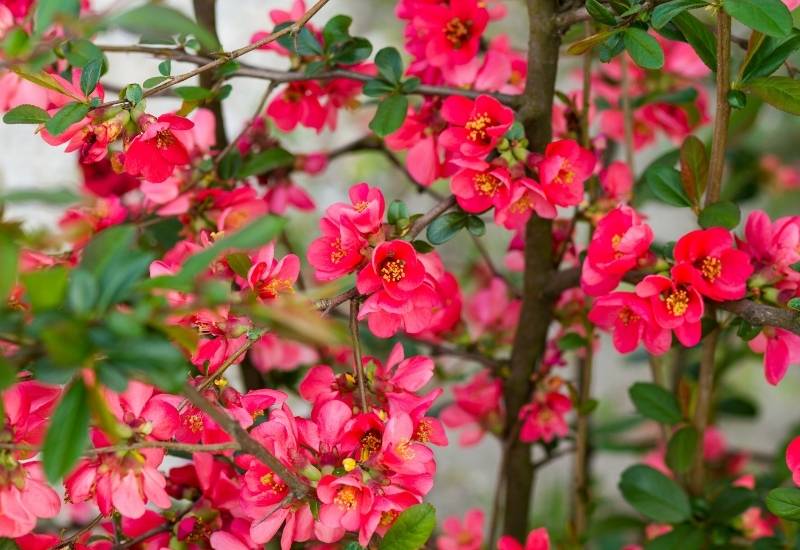
Flowering quince or Japanese quince is an elegant and showy early spring blooming shrub with pink flowers. The flowers are round in shape, cupped and quite dense on the almost bare branches of this plant.
The color range goes from white to red and even green, and it “specializes” in delicate and pastel hues, though there are varieties with vibrant colors too, like ‘Double Take’ and ‘Crimson and Gold’.
There are single, semi double and double cultivars too, like the pale pink ‘Geisha Girl’ (semi) and the lime green ‘Kinshiden’ (full).
Oval and smooth looking foliage will start to grow as the blossom is in full swing, and they will stay on until frost, giving your gardens structure and depth.
Flowering quince offers a mix of showy flowers with an oriental look and a very “temperate and forest” branches, habit and foliage; this composition makes it ideal for informal gardens with a Western but also Japanese, Chinese, or more generally Asian design.
5: Koreanspice Viburnum (Viburnum carlesii)
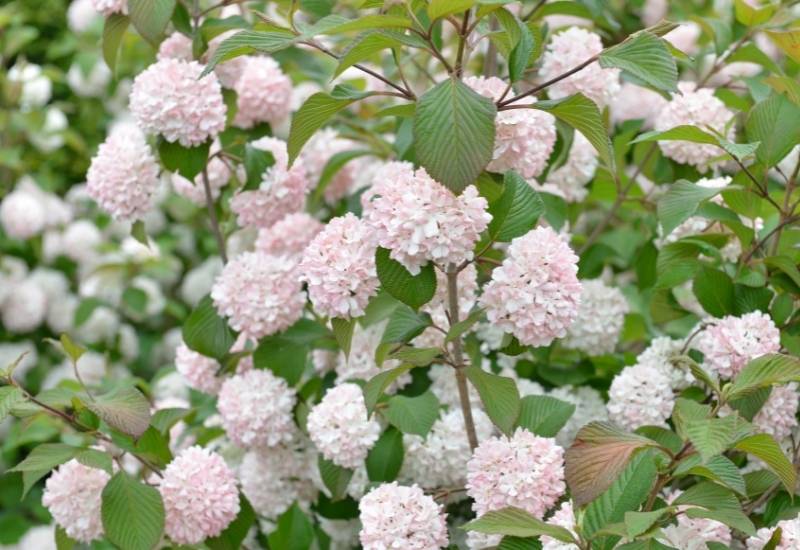
Koreanspice viburnum has bright and fresh look, perfect for spring! Its round semispherical clusters come from red buds but open to white and light pink florets, packed together and frequent on the branches.
They will also grace your garden in summer, with red fruits that attract birds. What’s more, the broad elliptical leaves, light green in color, will stay on till the cold season comes. And in fall, they will turn red or even burgundy in color! It is also a winner of the Great Plants Award.
The bright and herbacesous appearance of Koreanspice viburnum will find its place in traditional and informal gardens, in borders, hedges or windscreens. It is low maintenance and cold hardy, so, good for naturalized areas too.
6: Mock Orange (Philadelphus coronarius)
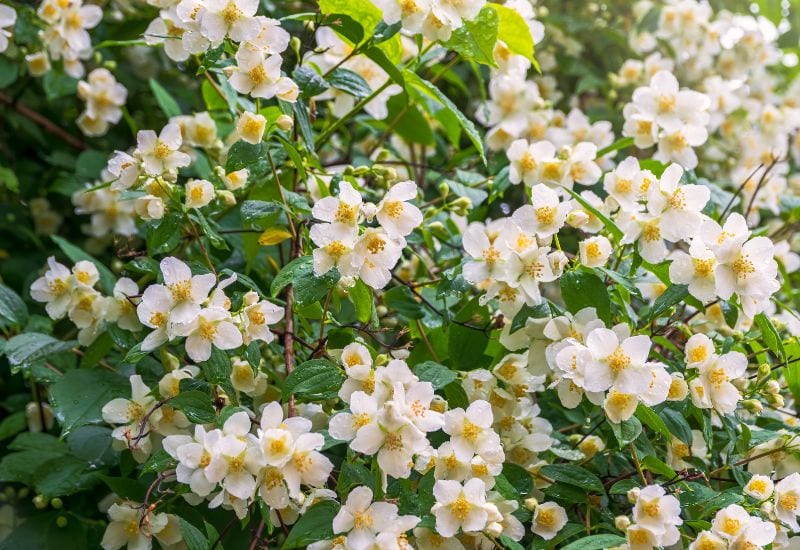
A mock orange shrub will bring some Mediterranean spring feel to your garden, even if you live in a cold state… The blooms are plenty, fragrant and bright white with canary yellow centers.
They have four petals and they reach 1 inch across each (4.5 cm). The leaves are elliptical, curved and bright green. Even the bark is interesting; it is light brown and exfoliating.
The overall effect is a bit like that of an orange tree, though really they are different when you get close… And no, it won’t give you the fruits! But in a garden, it brings lots of light and candor, and vitality.
Grow mock orange where you can enjoy its scent; maybe near a patio, or near a resting place; use informal planting for this shrub, in borders or hedges, so you get the best of it.
7: Winter Heath (Erica carnea)
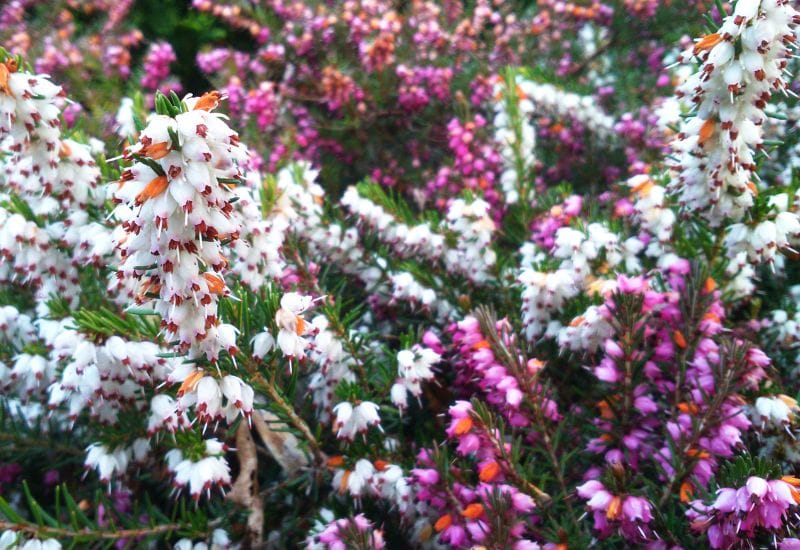
Winter heath is a traditional type of heather with very long and jaw dropping blooms! Small in size but with a lot of personality and energy, this long blooming shrub can turn whole valleys pink or white or purple in the wild, and you can enjoy a “slice” of this in your garden too, with little effort!
Each plant fills with an incredible number of tiny urn shaped flowers, and they stay on from winter to the end of spring. The foliage will stay on, with its fine needle structure, giving you an all year round presence.
Winter heath is cold hardy, disease free and low maintenance; its small size makes it perfect for beds, containers, rock gardens but also for banks and slopes and even as groundcover.
8: ‘Spring Mist’ Camellia (Camellia ‘Spring Mist’)
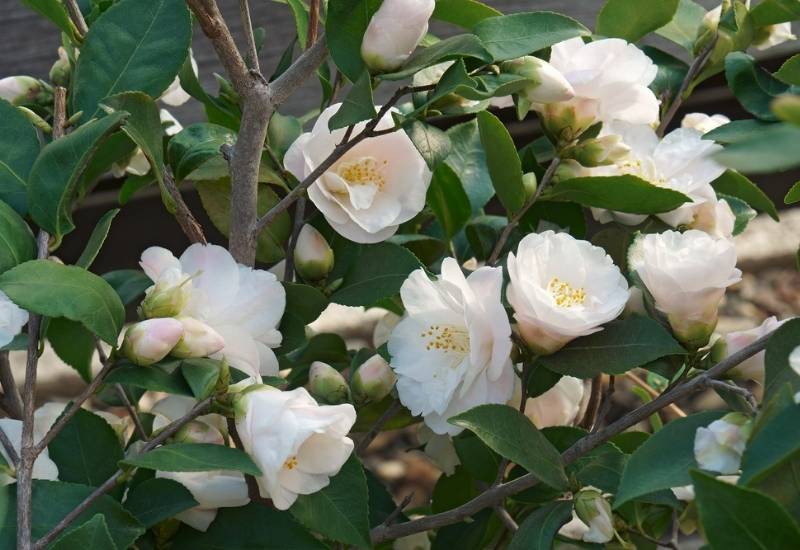
Of all the camellias we chose ‘Spring Mist’ for two main reasons: its unusual color and long blooms… this exceptional hybrid has semi double light cream rose flowers, bell shaped on the whole, about 2 inches wide (5.0 cm).
It will bloom in spring, wherever you live, but in the Northern Hemisphere it will blossom from October to March; in the Southern Hemisphere it will do it from March to August!
It is an elegant beauty that requires sine care and the right soil conditions; but if you can, this shrub will really add to your garden or terrace, also thanks to its glossy dark green oval foliage.
‘Spring Mist’ wants a very prominent place in your garden or in your terrace; it wants to be looked at. Containers may be the best options to keep the soil acidic and shelter it over winter.
9: ‘Magician’ Deutzia (Deutzia x hybrida ‘Magicien’ Lemonie’)
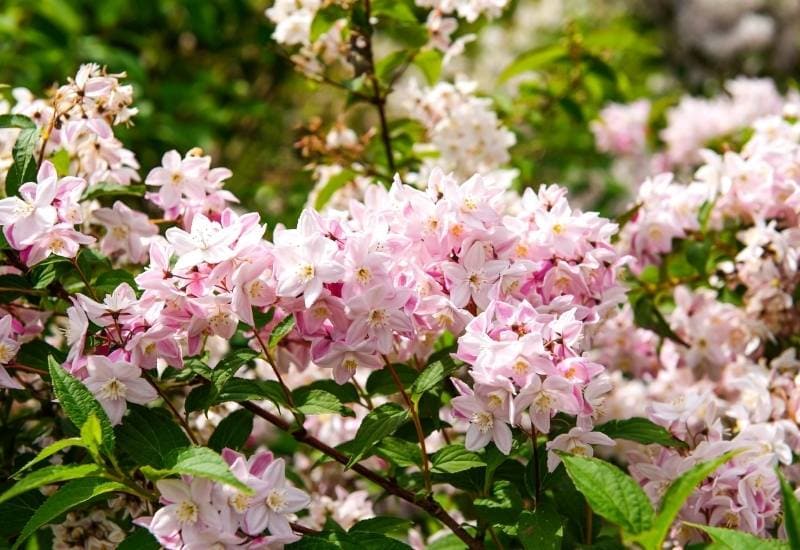
The clusters of star shaped flowers of ‘Magician’ deutzia are a wonderful splash of brightens in spring gardens, and they continue into the summer months.
They are white with a yellow dot in the center and bright magenta at the tips of the petals. They almost cover the whole shrub for a fortnight, and after that, you can still enjoy the elliptical bright green foliage of this upright and spreading shrub till winter comes. It has won the Gold Medal Award of the Pennsylvania Horticultural Society.
Grow ‘Magician’ deutzia on river banks and in slopes, or against walls to cover them off; but even in normal borders and hedges it will do just fine, even in natural looking and woodland areas.
10: Garland Flower (Daphne cneorum)
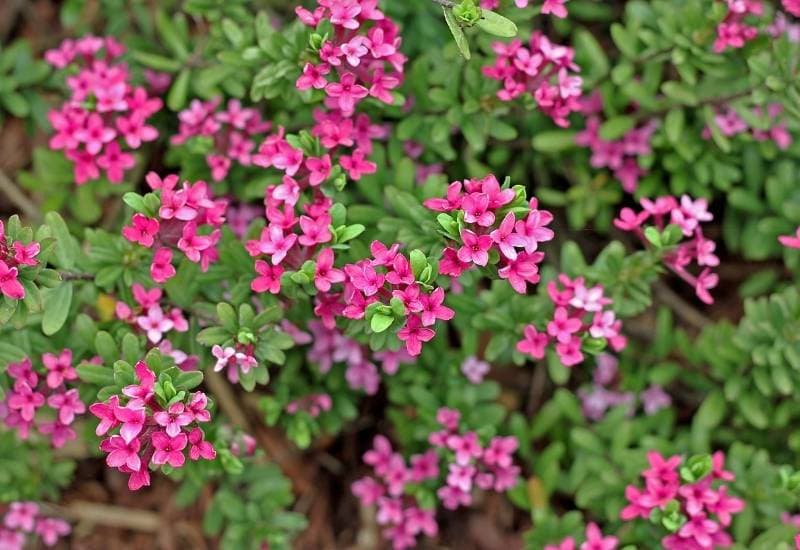
For a small draping flowering bush that flowers in spring and beyond, garland flower is just perfect.
The trailing habit of this plant brings the bright magenta blooms over rocks, containers and walls in a profusion of fragrant and star shaped florets that look like a carpet of vibrant coloring.
The main blossom is in spring, but you will see smaller ones in summer too. The branches look lovely even afterwards, with its many, small oval glossy dark green leaves that stay all all year round!
Garland flower is an ideal choice for flower beds, rock gardens and containers; ideal for terraces and places near your home, you can also use it as ground cover.
11: ‘Tor’ Birchleaf Spirea (Spiraea betulifolia ‘Tor’)
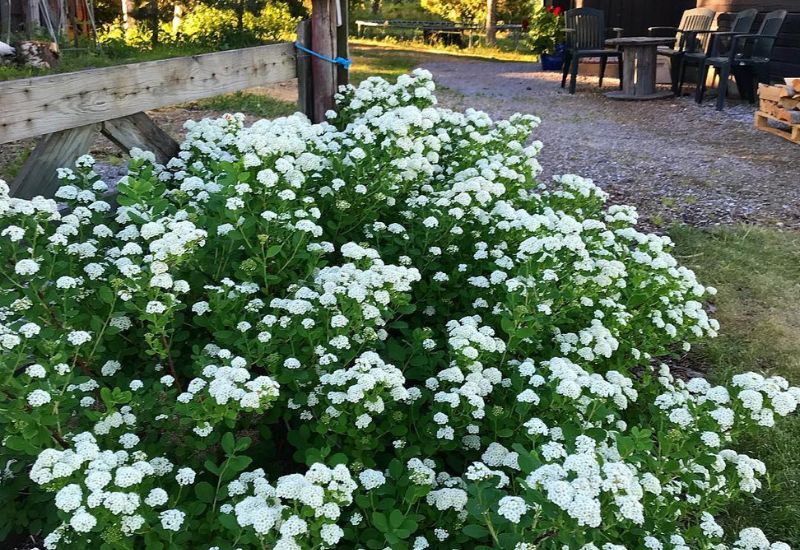
‘Tor’ birchleaf spirea is a shrub that blooms in spring, but its beauty but valuable in gardens also late in the season.
The round clusters of beautiful white flowers that open in abundance on the dark green, elegant foliage of this bush in late spring will stay on till the first weeks of summer.
Then, you will have a very green plant with lush foliage in summer and then… As fall approaches, the leaves turn bright yellow, then orange and finally red an purple.
You get two completely different effects in the early months of the year and then when the days get shorter and winter is round the corner.
‘Tor’ birchleaf spirea looks lovely in borders and hedges in traditional, informal but also urban and courtyard gardens, giving you an ever changing show most of the year.
12: Mountain Witch Alder (Fothergilla major)
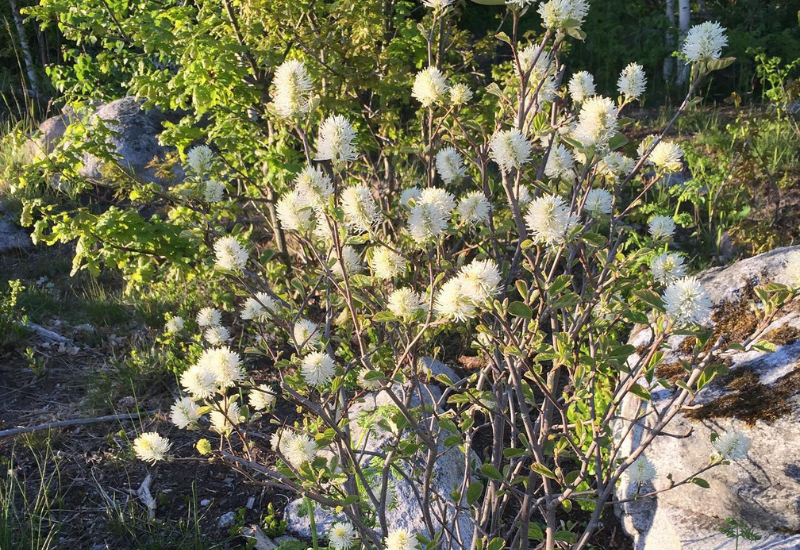
Mountain witch alder is a deciduous shrub with original flowers in spring and amazing foliage till frost.
The blooms look like white bottle brushes, pointing up from the branches of this bush when the foliage is still young and light green in color, from mid spring.
Then, the lush leaves will darken in shade through the summer months, finally turning yellow and red in fall, before falling and leaving the intricate light brown branches naked during the winter months. It is a winner of the Award of Garden Merit by the Royal Horticultural Society.
Mountain witch alder is a woodland looking, temperate deciduous shrub, strong and loved by butterflies and birds; it looks good in natural looking gardens, including woodland areas and naturalized plots of land.
13: ‘Queen of Sweden’ English Rose (Rosa ‘Queen of Sweden’)
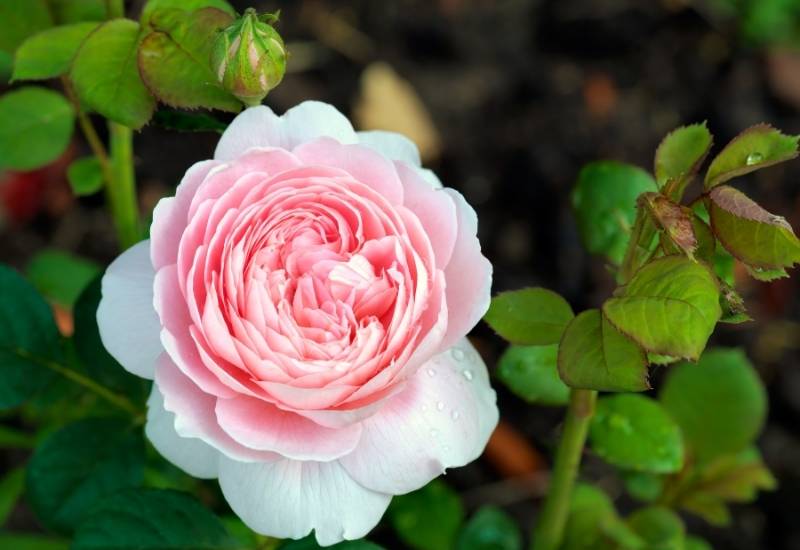
Early flowering roses like the English shrub cultivar ‘Queen of Sweden’ will start in mid to late spring, but they can keep going till frost!
And our protagonist has fully double cupped heads with up to 41 petals of the most candid and bright light pure soft pink color!
These are about 3 inches across (7.5 cm) and abundant on the glossy dark green leaves that are copper in shade when they are young. As a rose bush, it also has an unusually upright habit, which makes for good cut flowers.
This repeat bloomer is great in beds and borders, as a wall side shrub in any traditional looking garden, like an English country garden, especially if you are after the romantic look!
14: ‘Emerald Snow’ Chinese Fringe Flower (Loropetalum chinense ‘Emerald Snow’)
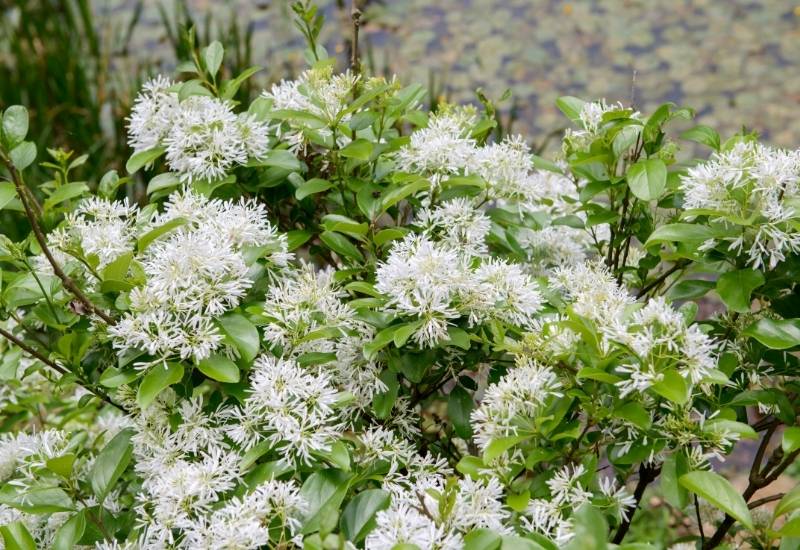
‘Emerald Snow’ Chinese fringe flower is a dwarf and dense blooming shrub that punches far above its weight though!
The flowers completely fill it in spring, and they come back in smaller numbers repeatedly till frost. They look like fluffs of cotton, or many white spiders, the petals look like little strings – very unusual. The green and elliptical foliage is light green and it persists all year round because is also evergreen!
I can see ‘Emerald Snow’ well in a front or back yard in a suburban garden, but of course it also looks good in all informal gardens, especially woodland and natural looking ones.
15: Fremont Barberry (Mahonia fremontii)
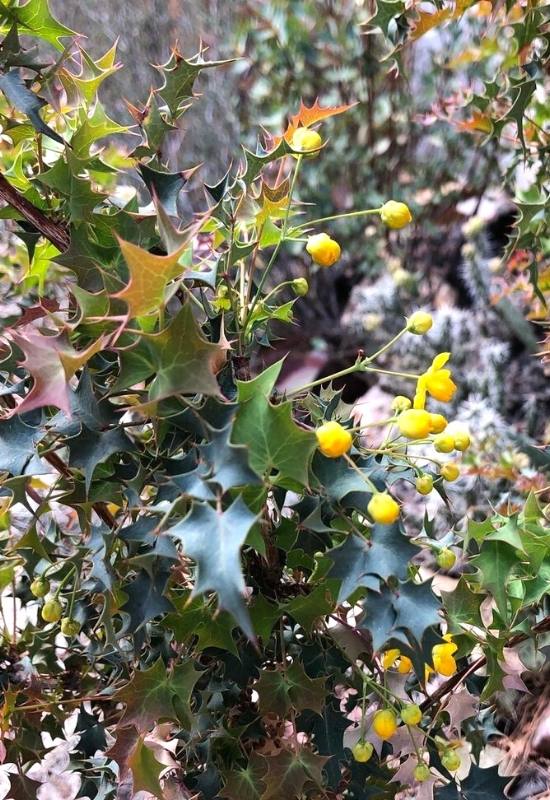
Fremont barberry is yet another spring flowering shrub with year round interest! The yellow flowers come in straight branches in mid spring and stay on till early summer.
They look a bit like mini daffodils, in clusters and very airy in appearance. And they have a very sweet fragrance, similar to honey. They become green fruits that become purple when they ripen. You can eat them, but they are bitter.
The foliage is evergreen, or better… It is burgundy at first, then it turns green and then blue, and then the color display starts all over again!
The leaves are leathery and spiny, like those of holly and in a very regular and decorative formation.
Fremont barberry is perfect for dry looking, xeric gardens, desert gardens and gravel gardens, but it will easily mix in with other plants in most informal borders, beds and rock gardens.
16: ‘Else Fry’ Rhododendron (Rhododendron ‘Else Fry’)
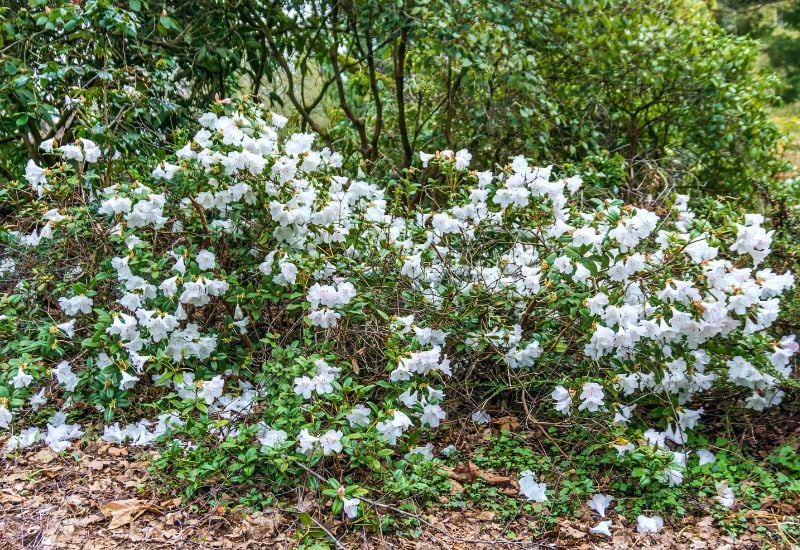
There are many rhododendrons that flower in spring, some big, some small, and of many colors. We chose ‘Else Fry’, a little one that fan fit in most gardens and with amazing white blooms with a gold center and a magenta blush inside, and a pink one on the outside.
Trumpet shaped and frilly they are massive for a rhododendron: 4 inches wide (10 cm)!!! All on a compact bush with dark green foliage that stays on in winter.
This is a show stopper, and in fact it has won the Rhododendron of the Year Award by the American Rhododendron Society for the South West, no surprise there!
‘Else Fry’ is an exceptional variety of rhododendron that will suit most informal settings, even exotic ones, thanks to its huge blooms.
It is also suitable for containers and terraces, and maybe this is best to keep the soil acidic. One thing though: don’t hide it at the back of your yard – plant it where everybody can see its eye catching beauty!
Welcome Spring to Your Garden with Flowering Shrubs
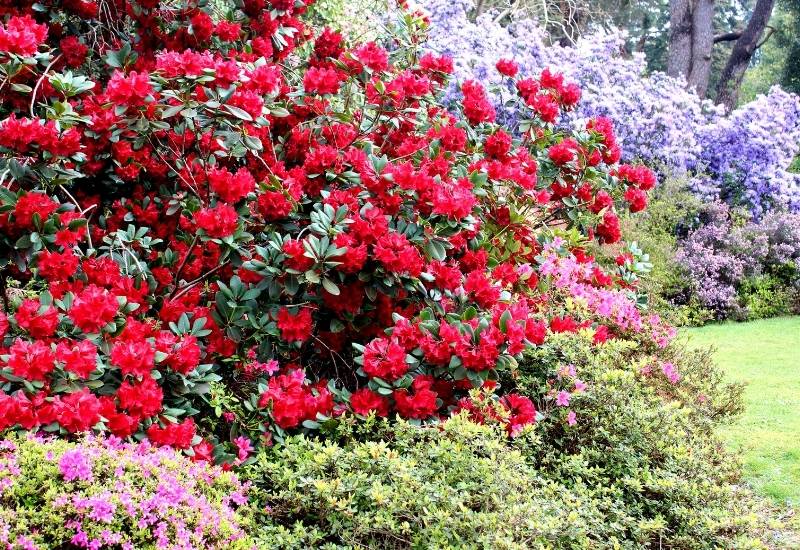
From roses to lilacs, spring offers a huge range of shrubs to brighten up your garden or terrace; so, pick your favorite(s) and get ready for an early start – I am sure there is at least one that suits your taste and needs…

Written By
Amber Noyes
Amber Noyes was born and raised in a suburban California town, San Mateo. She holds a master’s degree in horticulture from the University of California as well as a BS in Biology from the University of San Francisco. With experience working on an organic farm, water conservation research, farmers’ markets, and plant nursery, she understands what makes plants thrive and how we can better understand the connection between microclimate and plant health. When she’s not on the land, Amber loves informing people of new ideas/things related to gardening, especially organic gardening, houseplants, and growing plants in a small space.
